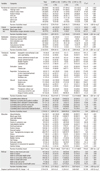Abstract
Purpose
The purpose of this study was to examine the current status of home care nursing services provided by community health nurses and to identify barriers to the services.
Methods
A cross-sectional survey was conducted with three types of community health care nurses. Participants were 257 nurses, 46 of whom were hospital based home care nurses, 176 were community based visiting nurses, and 35 were long term care insurance based visiting nurses. A structured questionnaire on 7 domains of home care nursing services with a 4-point Likert scale was used to measure activities and barriers to care. Data were analyzed using SPSS WIN 21.0 program.
Results
Hospital based home care nurses showed a high level of service performance activity in the domain of clinical laboratory tests, medications and injections, therapeutic nursing, and education. Community based visiting nurses had a high level of service performance in the reference domain. Long term care insurance based visiting nurses showed a high level of performance in the service domains of fundamental nursing and counseling.
Conclusion
The results show that although health care service provided by the three types of community health nurse overlapped, the focus of the service is differentiated. Therefore, these results suggest that existing home care services will need to be utilized efficiently in the development of a new nursing care service for patients living in the community after hospital discharge.
References
1. Korea Institute for Health and Social Affairs. 2013 patient survey [Internet]. Seoul: Ministry of Health & Welfare, Korea Institute for Health and Social Affairs;2013. cited 2014 April 22. Available from: http://stat.mw.go.kr/front/statData/publicationView.jsp?bbsSeq=11&nttSeq=21200&menuId=45.
2. Holland DE, Mistiaen P, Bowles KH. Problems and unmet needs of patients discharged "home to self-care". Prof Case Manag. 2011; 16(5):240–250.
3. Holland DE, Knafl GJ, Bowles KH. Targeting hospitalised patients for early discharge planning intervention. J Clin Nurs. 2013; 22(19-20):2696–2703. DOI: 10.1111/j.1365-2702.2012.04221.x.
4. Moon OR, Kang SH, Lee EP, Jwa YK, Lee HS. An analysis on the characteristics of high cost patients in the regional medical insurance program. Korean J Health Policy Adm. 1983; 3(1):53–83.
5. Kim KA, Shine EK, Baek SJ, Choi YS, Jung KT. A study on catastrophic user-paid expenditure attributes for patient in national health insurance. Korean J Health Econ Policy. 2011; 17(3):75–99.
6. Askren-Gonzalez A, Frater J. Case management programs for hospital readmission prevention. Prof Case Manag. 2012; 17(5):219–226. DOI: 10.1097/NCM.0b013e318257347d.
7. Lee E, Yu SH, Lee HJ, Kim S. Factors associated with unplanned hospital readmission. Korean J Hosp Manage. 2010; 15(4):125–142.
8. Lee JH, Kim YM, Kang SH. A study patient management for both planned and unplanned readmission in a medium-size hospital. Health Serv Manag Rev. 2008; 2(1):11–17.
9. Oh HJ, Yu SH. A case-control study of unexpected readmission in a university hospital. Korean J Prev Med. 1999; 32(3):289–296.
10. Kassin MT, Owen RM, Perez SD, Leeds I, Cox JC, Schnier K, et al. Risk factors for 30-day hospital readmission among general surgery patients. J Am Coll Surg. 2012; 215(3):322–330. DOI: 10.1016/j.jamcollsurg.2012.05.024.
11. Toronto Central Community Care Access Centre. 50 Years of caring for Toronto [Internet]. Toronto, CA: Author;2014. cited 2014 September 22. Available from: http://healthcareathome.ca/torontocentral/en/performance/Documents/TOCCAC-AnnualReport-FullProof-12-HighRes.pdf#sthash.0gUhWxEh.dpuf.
12. Australian Government, Department of Health and Ageing. Transition care program 2011 [Internet]. Canberra, AU: Commonwealth of Australia Year;2011. cited 2014 August 7. Available from: https://bendigohealth.mhr.com.au/Upload%5CPDs%5C51495-TransCareProgGuidelines2011.pdf.
13. Balaban RB, Weissman JS, Samuel PA, Woolhandler S. Redefining and redesigning hospital discharge to enhance patient care: A randomized controlled study. J Gen Intern Med. 2008; 23(8):1228–1233. DOI: 10.1007/s11606-008-0618-9.
14. Jack BW, Chetty VK, Anthony D, Greenwald JL, Sanchez GM, Johnson AE, et al. A reengineered hospital discharge program to decrease rehospitalization: A randomized trial. Ann Intern Med. 2009; 150(3):178–187.
15. Tsuchihashi-Makaya M, Matsuo H, Kakinoki S, Takechi S, Kinugawa S, Tsutsui H. Home-based disease management program to improve psychological status in patients with heart failure in Japan. Circ J. 2013; 77(4):926–933.
16. Shin HS, Oh JJ. Case management for medical aid beneficiaries in Korea: Findings from case-control study. Asian Nurs Res. 2014; 8(4):274–281. DOI: 10.1016/j.anr.2014.10.001.
17. Ministry of Health & Welfare. Hospital based home care nursing program guidelines. Seoul: Author;2010. cited 2014 December 10. Available from: http://www.mw.go.kr/front_new/al/sal0101vw.jsp?PAR_MENU_ID=04&MENU_ID=040101&CONT_SEQ= 237214&page=1.
18. Ministry of Health & Welfare, Korea Health Promotion Foundation. 2013 Integrated community health promotion program [Internet]. Seoul: Author;2013. cited 2013 December 10. Available from: http://www.mw.go.kr/front_new/jb/sjb0601vw.jsp?PAR_MENU_ID=03&MENU_ID=03160501&CONT_SEQ=286506&page=1.
19. Ministry of Health & Welfare. Main contents of the act of long-term care insurance for the elderly [Internet]. Seoul: Author;2013. cited 2013 August 6. Available from: http://www.mw.go.kr/front_new/jb/sjb0403vw.jsp.
20. Lee SH, Lim JY. Strategies of home health care services linkages in Korea based on Delphi technique. J Korea Contents Assoc. 2012; 12(12):282–290.
21. Lim JY, Kim EJ, Choi KW, Lee JS, Noh WJ. Analysis of barriers and activating factors of visiting nursing in long-term care insurance. J Korea Contents Assoc. 2012; 12(8):283–299. DOI: 10.5392/JKCA.2012.12.08.283.
22. Chin YR, Lee I, Chang HS. Analysis of the effects and nursing intervention of home health care in public health centers. J Korean Community Nurs. 2004; 15(3):353–364.
23. Korea Health Industry Development Institute, Korean Health Promotion Foundation. The role and function of home healthcare based on the public health centers, hospitals and long-term care insurance [Internet]. Seoul: Ministry of Health & Welfare;2007. cited 2014 July 14. Available from: http://www.khidi.or.kr/fileDownload?titleId=118694&fileId=1.
24. Boter H. Multicenter randomized controlled trial of an outreach nursing support program for recently discharged stroke patients. Stroke. 2004; 35(12):2867–2872. DOI: 10.1161/01.STR.0000147717.57531.e5.
25. Harrison JD, Young JM, Solomon MJ, Butow PN, Secomb R, Masya L. Randomized pilot evaluation of the supportive care intervention "CONNECT" for people following surgery for colorectal cancer. Dis Colon Rectum. 2011; 54(5):622–631. DOI: 10.1007/DCR.0b013e31820bc152.
26. Lindpaintner LS, Gasser JT, Schramm MS, Cina-Tschumi B, Müller B, Beer JH. Discharge intervention pilot improves satisfaction for patients and professionals. Eur J Intern Med. 2013; 24(8):756–762. DOI: 10.1016/j.ejim.2013.08.703.




 PDF
PDF ePub
ePub Citation
Citation Print
Print




 XML Download
XML Download